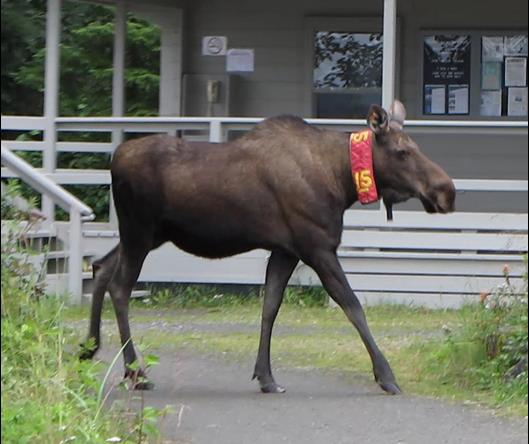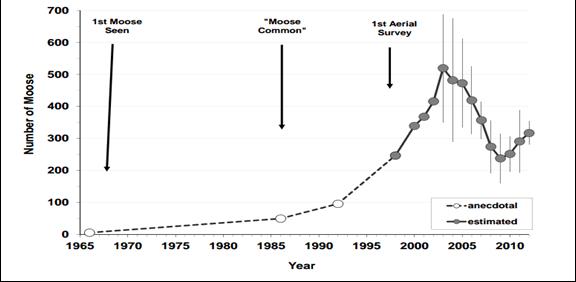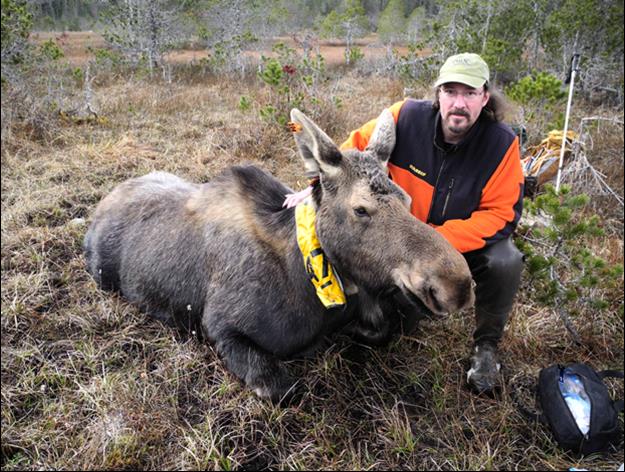How many moose occupy the Gustavus Forelands? Is the population growing?
Project Dates

Ongoing since 2000
Did You Know?
Winter moose densities on the Gustavus Forelands are among the highest in the state of Alaska at over 3 moose/km2.
Introduction

Moose are relative newcomers to the Gustavus/Glacier Bay area. Migrating from the Haines area, most likely through Endicott Gap, the first arrivals were seen here in the mid-1960s. The population grew slowly at first, then explosively in the 1990s, and then started to decline in the 2000s. Biologists are familiar with this pattern of population “irruption” following colonization of a new area, then subsequent decline as the carrying capacity of the habitat is reached and exceeded. Alaska Department of Fish and Game (ADF&G) researchers have been watching, recording, and responding with appropriate management actions (outside park boundaries) as this pattern has played out in this “trans-boundary” population.
The objective of the current research is to learn more about the interplay between moose and their habitat by closely monitoring individually marked animals and the condition of their food resources. Researchers have collected field data focused on characterizing moose diet composition, forage availability and quality, movement patterns, nutritional condition, reproduction and survival, and, ultimately, population dynamics. By linking these characteristics to measures of habitat conditions, the researchers can evaluate the correlation between habitat quality and the health of the population.
Research helps inform decisions on regulating the annual Gustavus moose hunt. ADF&G decided to reduce the population (by increasing harvest) during 2003-2008 in order to avert the typical irruptive population “crash” and maintain a population in closer equilibrium to the available food supply.
Methods

The researchers have captured and radio-collared about 83 female moose in Gustavus; 35-40 are still alive and currently being monitored. The movements of the moose are recorded by radio– and satellite-tracking, and the moose are monitored at regular intervals to estimate parturition and twinning rates, calf survival, and adult survival. Fresh fecal pellets are collected in winter for laboratory analysis of progesterone for pregnancy determination. Willow plants are marked and monitored to assess browse availability and utilization. Moose population abundance and composition are estimated annually via winter aerial surveys. In recent years, many hours were spent in the field observing and recording moose feeding behavior and activity budgets.
Findings
In winter, the population favors the low-elevation areas near the community of Gustavus. In summer, most migrate to areas inside the park, especially the Beardslee Islands, Excursion Ridge, and Beartrack River areas. Interestingly, the calves of moose that migrate into the park are twice as likely to survive until fall than those that remain in Gustavus. The causes are still under investigation, but disturbance by dogs in Gustavus is thought to be a factor.
The moose population in Gustavus is typical in that adult female survival is relatively high (90% average survival annually), but calf survival is relatively low (30%). The high survival of adults combined with healthy pregnancy (90%) and twinning (40%) rates balance out low calf survival and result in the modest growth rate of the current population.
The winter diet is low-quality, predominantly willow twigs and horsetail, which only help to slow the loss of critical fat and protein reserves acquired during the summer and fall. In this state of negative energy balance, a hard winter can exact a heavy toll.
Learn More
ADF&G Website www.adfg.alaska.gov/has a wealth of information on wildlife, including articles on moose research in Gustavus.
Last updated: September 15, 2016
